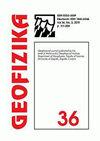Fractal analysis of seismoacoustic signals of near-surface sedimentary rocks in Kamchatka
IF 1.1
4区 地球科学
Q4 GEOCHEMISTRY & GEOPHYSICS
引用次数: 3
Abstract
We studied, by the mono- and multifractal detrended fluctuation analysis (DFA), time fluctuations in the dynamics of seismoacoustic data, recorded in Karymshina site, which is located in a seismic area of Kamchatka. We took a series of seismoacoustic responses to the regional seismic events with the mag-nitudes M > 4 for the period 2017–2018. The series was divided into three groups (high, medium and low) based on the amplitude of recorded seismoacoustic re-sponse. Background noise segments of the signals demonstrated monofractal behavior similar to white noise by almost constant values of generalized Hurst exponent Hq≈0.5 and very small width of the multifractal spectrum Δa ≈ 0.1. Analysis of the high amplitude seismoacoustic signals with clear P-, S- and coda waves showed that P- and S-waves demonstrate wider multifractal spectrum (ΔaP = 0.37, ΔaS = 0.35) and range of generalized Hurst exponents Hq in com-parison with coda wave, characterized by almost constant Hq and minimal width of multifractal spectrum (ΔaCODA = 0.13). We showed that the properties of the multifractal spectrum could be used in detection of seismic wave arrival, estima-tion its duration and separation of P-, S- and coda waves. Application of the monofractal DFA in a sliding window showed that the acoustic signal transits from monofractal and uncorrelated background noise (Hurst exponent equals to 0.5) into the long-range dependent state during seismic waves arrival, that is helpful in analysis of the signals, particularly in case of low amplitude acous-tic responses, usually demonstrating an unclear waveform. Difference in mul-tifractal spectrum width between the original low amplitude signal and its sur-rogates, obtained by random shuffling showed that the multifractality in the signal is dominantly due to long-range correlations.堪察加半岛近地表沉积岩地震声信号的分形分析
我们通过单分形和多重分形去趋势波动分析(DFA)研究了位于堪察加地震区的Karymshina场地记录的地震声学数据动力学中的时间波动。我们对2017-2018年期间M>4的区域地震事件进行了一系列地震声学响应。根据记录的地震声响应幅度,该系列被分为三组(高、中、低)。信号的背景噪声段表现出类似于白噪声的单分形行为,广义赫斯特指数Hq≈0.5几乎为常数值,多重分形谱的宽度Δa≈0.1非常小。对具有清晰P波、S波和尾波的高振幅地震声信号的分析表明,与尾波相比,P波和S波表现出更宽的多重分形谱(ΔaP=0.37,ΔaS=0.35)和广义Hurst指数Hq的范围,其特征是Hq几乎恒定,多重分形谱的最小宽度(ΔaCODA=0.13)。我们表明,多重分形频谱的性质可以用于地震波到达的检测、持续时间的估计以及P波、S波和尾波的分离。单分形DFA在滑动窗口中的应用表明,在地震波到达期间,声学信号从单分形和不相关的背景噪声(赫斯特指数等于0.5)转变为长程相关状态,这有助于分析信号,特别是在低振幅声学响应的情况下,通常表现出不清楚的波形。通过随机混洗获得的原始低振幅信号与其结果之间的多重分形谱宽度的差异表明,信号中的多重分形主要是由于长程相关性。
本文章由计算机程序翻译,如有差异,请以英文原文为准。
求助全文
约1分钟内获得全文
求助全文
来源期刊

Geofizika
地学-地球化学与地球物理
CiteScore
1.60
自引率
0.00%
发文量
17
审稿时长
>12 weeks
期刊介绍:
The Geofizika journal succeeds the Papers series (Radovi), which has been published since 1923 at the Geophysical Institute in Zagreb (current the Department of Geophysics, Faculty of Science, University of Zagreb).
Geofizika publishes contributions dealing with physics of the atmosphere, the sea and the Earth''s interior.
 求助内容:
求助内容: 应助结果提醒方式:
应助结果提醒方式:


